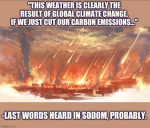Summer 1936 was unusually warm, especially with arid conditions in the Great Plains and Midwest exacerbating the heat. Many of the high temperature records set that year in the region still hold today, the National Weather Service
reported.
A claim that was made about 1936 being the hottest year.
----------------------------------------------------------------------------------------------------------------------------------------------------------------
However, National Oceanic and Atmospheric Administration
data shows that in the contiguous U.S., the first nine months of 2023 were 1.64°F warmer than January through September 1936. (An agency spokesperson said October data is still being reviewed.)
Globally, summer 2023 was the hottest on record, NASA
reported.
Climate scientists say that the 1930s heat waves in the U.S. are often singled out to rebut the existence of global climate change.
“In climate science, trend is the true indicator of climate change, not a particular cherry-picked year. Recent summers in the United States are some of the worst summers we have on record,” said Randall Cerveny, a geographical sciences professor at Arizona State University.
There’s
abundant evidence that the Earth is warming exponentially because of human-caused climate change.
Heat waves, or persistent periods of unusually hot days, are becoming
more frequent and intense in the U.S. and other parts of the world. 2023 has already broken
several heat records, and climate scientists estimate that it will likely be the
hottest on record globally. (poynter.org/fact-checking/2023/was-united-states-warmer-1936)


